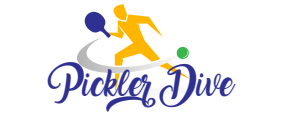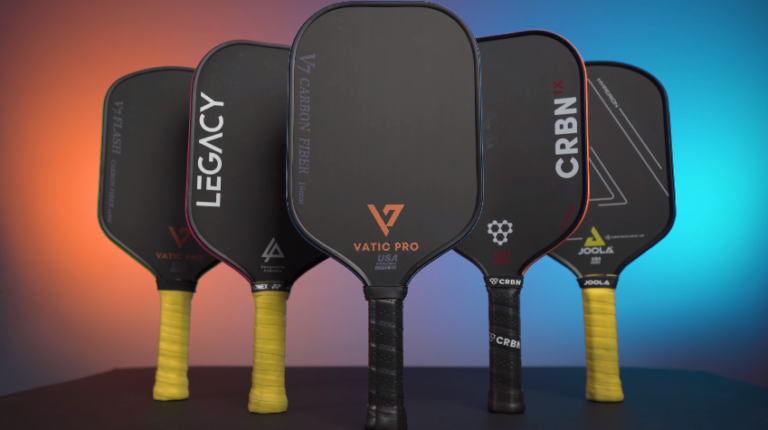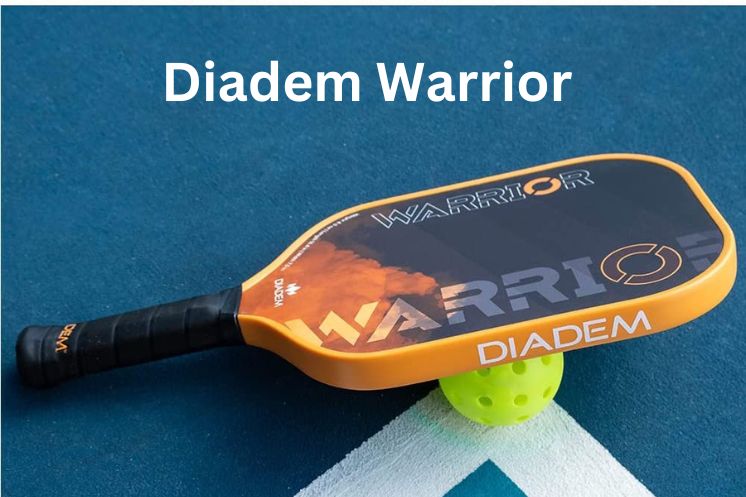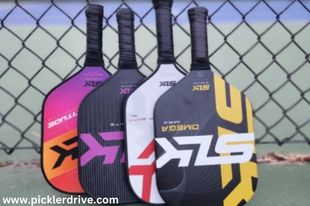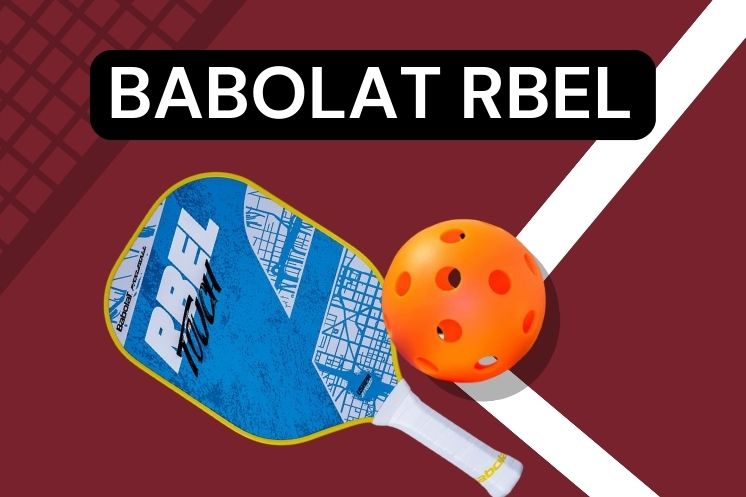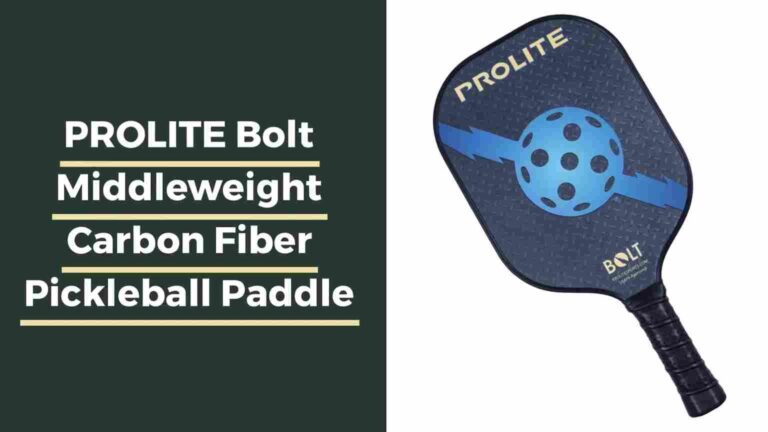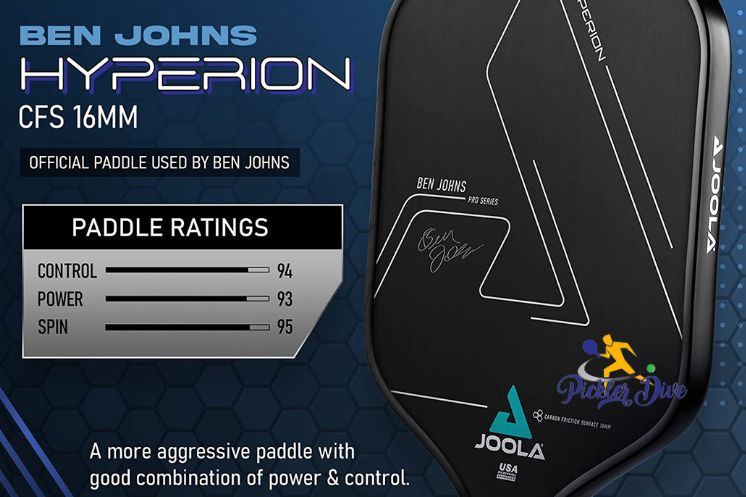Whether you’re a novice or an experienced player, understanding pickleball serving rules is crucial. To help you stay compliant and improve your performance, we’ve prepared a brief guide on serving in pickleball. In this article, we’ll explain the regulations, fundamental techniques, and practical advice to enhance your serving abilities. Are you prepared? Let’s get started!
Pickleball Serving Rules & Tips For Beginners To Advance Player
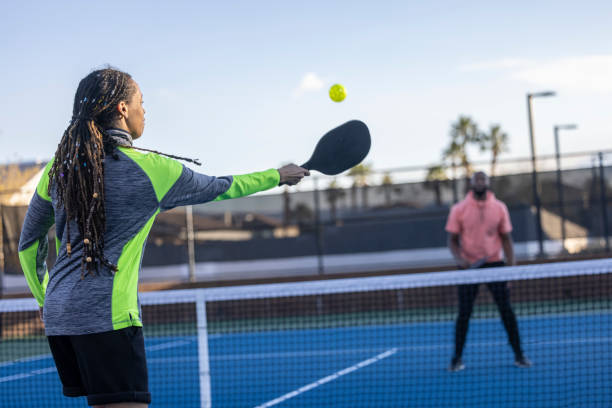
Knowing The Rules Makes Pickleball More Enjoyable
Pickleball is a highly addictive sport that combines elements of badminton, tennis, and ping-pong and has taken the nation by storm. It seems like everyone is playing it, and if you haven’t tried it yet, you soon will! To participate in tournaments and fully enjoy the pickleball craze, it’s essential to stay informed about the latest rule updates. However, don’t worry! By reading this article, you’ll acquire a solid understanding of pickleball serving regulations, which will become as natural as riding a bike after a few practice sessions.
Serving in Pickleball from basics to advanced techniques
Pickleball has a unique scoring system where only the serving team can earn points, making serving a critical component of the game. A weak serve can cost you the game, as you won’t be able to score points. This article will guide you through the distinct rules of pickleball serving, which are essential for anyone interested in playing the game. Additionally, we’ll introduce some advanced serving techniques to help you improve your skills and take your game to the next level. Get ready to serve and dominate the court!
Serving Rules
When playing pickleball, the server must stand behind the baseline and select either the left or right side of the center line. Before serving, the server needs to declare the score and then hit the ball diagonally across the court into the service area. It’s essential to serve underhand and below the waist, as per the game’s rules.Moreover, it’s crucial to avoid landing the ball in the non-volley zone or touching the front service line. However, if the ball lands on any of the other lines, it’s still considered a valid serve. Once a point is earned, the server continues serving, but they must switch sides after every serve. Knowing these basic pickleball serving rules is essential to playing the game properly and staying within its guidelines.
Click here to download the Official USAPA Rulebook [PDF].
Singles Serving Rules
When playing singles in pickleball, each player serves until they lose a point, switching the side they serve from after each serve. If your score is even, you must serve from the right side of the court, and if it’s odd, you serve from the left. Additionally, it’s essential to announce the score before your opponent’s score when calling it out. These serving rules are crucial to playing singles pickleball properly and can help you gain an advantage over your opponent.
Doubles Serving Rules
In doubles pickleball, both players on a team take turns serving before the serve is switched over to the opposing team. During the start of the game, the second server of the first team is skipped. Following each sideout, the serve begins from the right side of the court and then switches sides after each serve. However, player positions and serving rules can be complex, including determining who serves first and from which side. The best way to learn these rules is to play with a more experienced player who can provide guidance. You can also read our article on doubles serve position rules for more information.
Two-Bounce Rule
Pickleball features a variety of distinctive regulations that are intended to keep the game fair and enjoyable. The two-bounce rule is one such regulation. According to the two-bounce rules, the serve must be returned with a groundstroke as well. Bob’s serve must therefore bounce for Alice to be able to return it. Then, before returning Alice’s return, Bob must wait and watch it bounce.
Players are then permitted to volley the ball after the serve and the first return. You strike the ball in a volley just before it hits the ground. A groundstroke is made if you let the ball bounce first.
Three Types of Advanced Servers
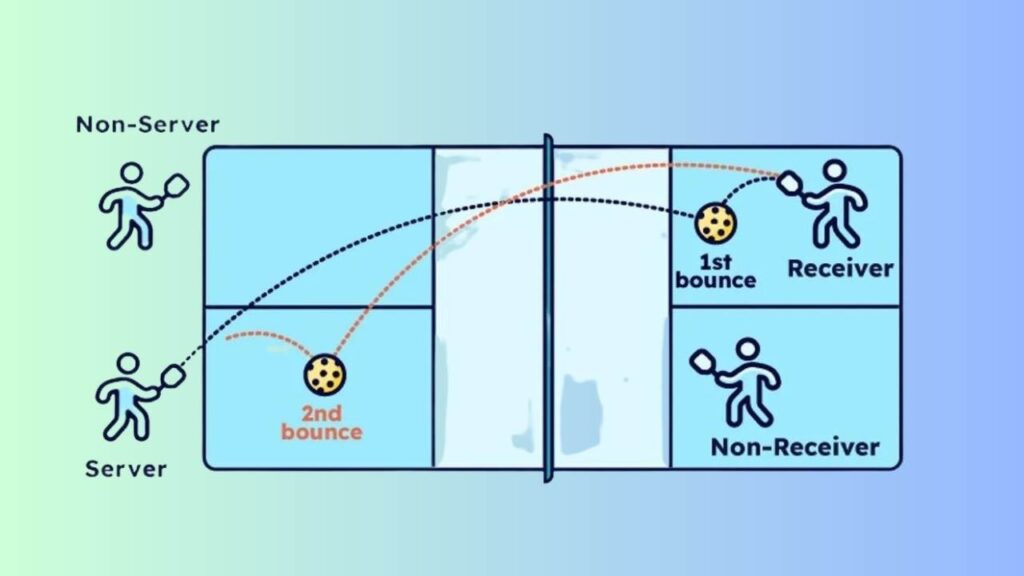
Once you’ve played pickleball a few times, you might start to question how to get better. The serve is a crucial component of the game because you can only score on your serve. I recently spoke with several of the more experienced players at our neighbourhood gym to get serving advice.
There are three types of serves in pickleball:
- High Soft Serve
- Power Serve
- Soft Angle Serve
Each of these techniques has advantages. Mixing up your serves can keep your opponent guessing and greatly improve your game.
High Soft Serve
A popular serving technique in pickleball is the high-soft serve, which involves hitting a high arc deep into the opponent’s court. This serve can be used effectively by players of all levels, from beginners to those ranked at 5.0 (check out more about pickleball rankings). The high-soft serve offers a lot of variety, making it ideal for changing the pace of the game and keeping opponents guessing.
When executing a high-soft serve, players have the option to aim for either the back or front of the serve area. This can be particularly effective in forcing opponents to move and get out of position, thereby creating opportunities for follow-up shots.
When to Use
While you might assume that hitting the ball hard and fast is always the best strategy, pickleball is a game that relies heavily on finesse. If your opponent becomes accustomed to returning your power serves, using a high-soft serve can be a great way to mix things up and keep them off-balance. This type of serve can also be used to lure the other team closer to the net, giving you an opportunity to hit a powerful serve that will be harder for them to return.
Advantages
The high-soft serve is a versatile and effective technique suitable for players of all levels. Its slow, looping trajectory adds variety to the game and keeps your opponent off balance. Additionally, the high arc of the serve can force your opponent to remain at the back of the court, giving you more control over the game’s pace.
Moreover, this serve compels the other player to put their own spin on the ball. Unlike other serves, where the opponent can easily block the ball with their paddle, the high-soft serve requires more effort on their part. By making your opponent work harder, you increase the likelihood of them making an error, ultimately improving your chances of winning.
Power Serve
The power serve is a low, fast serve that is hit deep into your opponent’s court. It can be aimed at the forehand or backhand corner or directed straight at your opponent. While more challenging to execute than the high-soft serve, the power serve is an essential skill to develop if you want to elevate your pickleball game.
When to Use
If you notice that your opponent has a weak backhand, the power serve can be a great way to exploit their weaknesses and force them into making mistakes. Additionally, if your opponent is not particularly fast, hitting the ball straight at them can cause them to move to one side and struggle to return the ball. It’s always more challenging to return a serve when your feet are not set.
The power serve can also be used effectively in conjunction with the high-soft serve. After serving a few high-soft serves, your opponent may start moving forward. If they position themselves inside the court to return your serve, it’s an opportune moment to use a power serve aimed directly at their feet.
Advantages
The advanced power serve method is difficult and takes a lot of practise, but it’s worthwhile to perfect because it enables you to target particular areas of your opponent’s court. You can compel your opponent to use all of their shots by focusing on the forehand or backhand corners. The serve is difficult to return due to its speed and low trajectory, which also restricts the other player’s ability to line up their shots or add spin to the ball. Additionally, the quickness of this serve keeps the adversary back past the baseline, making it more challenging for them to move forward to the non-volley zone line.
Soft Angle Serve
The soft angle serve is the final among the three main types of serves used to add variety to the game. This shot drops close to the kitchen line and the sideline, with the ball’s bounce taking it outside of the court. The small target area makes the soft angle serve the most challenging among the three main serve types.
When to Use
The soft angle serve is effective in pushing your opponent towards the edge of the court, leaving a wide open lane on the far side that you can exploit for an easy score. This is particularly useful in doubles play, especially when your opponents are stacked on the same side to return the serve. By executing a well-placed soft angle serve, you can easily catch them off-guard and force them out of position, leaving an opening on the opposite side.
Advantages
The soft angle serve is a powerful tool for moving your opponent off the court, leaving an open lane on the far side for an easy score. This serve is especially effective in doubles when your opponents are stacked on one side. If executed properly, the serve can catch the opposing team out of position and create a lane on the opposite side. However, the soft angle serve is also the most challenging of the three main serve types, so it’s essential to focus on accuracy to avoid giving away points.
How to Serve an Ace
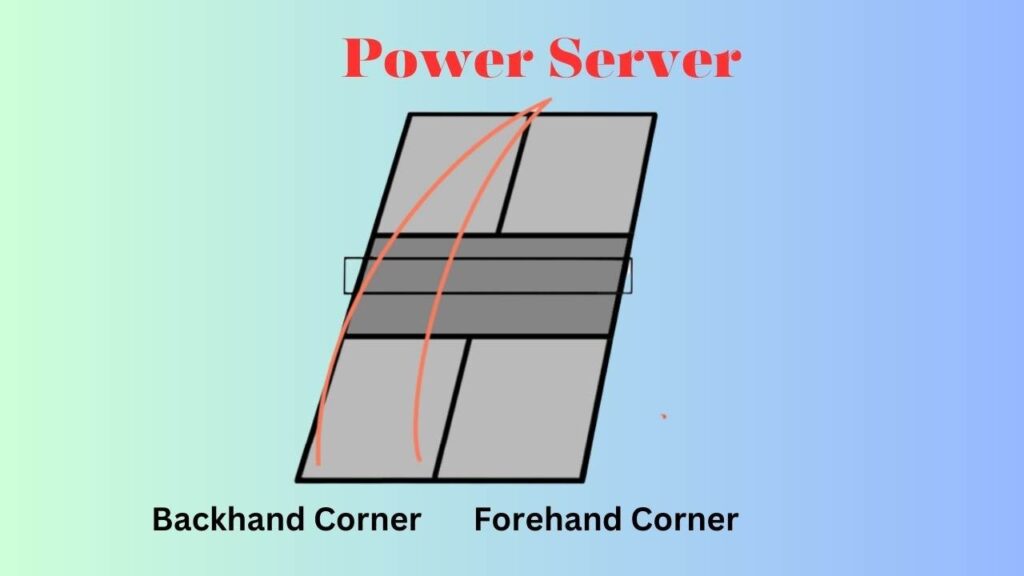
Pickleball balls are light and hollow, which means that hitting the ball hard can slow it down significantly due to wind resistance. Moreover, the underhand serve rule and the ball’s characteristics make it challenging to hit a serve past an opponent.
To serve an ace, it is best to start with a few soft, short serves. This will draw the opponent forward and create an opportunity to hit a power serve aimed at their feet when they are inside the court. Unless the player is very quick, it will be difficult for them to return the serve.
Put Spin on Your Serve
Another serving technique to consider is adding spin to the ball. If you have a background in other racket sports, this will come naturally to you. However, due to the smooth paddles and balls used in pickleball, it may be challenging to generate significant spin. Nevertheless, adding some side spin can make your power serves even more challenging to handle. To put spin on the ball, pull your paddle towards you sharply as you make contact with the ball.
Why Should You Serve Deep in Pickleball?
In pickleball, deliberate and precise movements are more important than power. The game is mostly about mastering ball placement rather than hitting hard. Although there are situations where power is necessary, it’s better for beginners to focus on serving with accuracy and control rather than trying to hit the ball with all their strength.
To serve deep in pickleball, you hit the ball towards the back of the service court while still keeping it inbounds. This tactic forces the receiver to stand farther away from the net, behind the baseline.
There are a lot of reasons you would want to do this, but the biggest advantage is that it gives you the chance to make room for a third shot drop. This shot is carried out by the serving team and entails correctly placing the ball in the non-volley area.
A gentler shot causes the ball to sort of die in the kitchen. The receiving team will have more distance to go to reach the third shot if they are pushed back on the baseline at the serve.
Serving deep is similar to playing chess two shots in advance rather than responding to what is presented to you.
So What Do You Need to Know?
To execute a legal serve in pickleball, you must strike the ball underhand from below the waist, for a volley serve, and allow it to bounce once for a drop serve. Both types of serves must be executed behind the baseline and land on the diagonally opposite service court.
If you serve deep, you can keep the receiving team on their toes while also creating space and opportunities for your team to execute a successful third shot. By keeping these tips in mind, you can play a more intelligent game while also adhering to legal serving techniques.
The 6 Key Pickleball Serving Rules
In pickleball, every point begins with the serve. This is because scoring is only possible when you (or your doubles team) are serving. Regardless of how well you play or how exciting the rally is, points can only be scored when it is your turn to serve.
Now, suppose it’s your turn to serve and score some points. How can you perform a legal serve? By adhering to six straightforward rules!

1. A Pickleball Serve Must Always Be Made With Either An Underhand Or Backhand Motion.
To clarify, this means the server’s arm must move in an upward arc when the ball is struck. No hitting from above, or from the side.
2. The point where the pickleball paddle makes contact with the ball must be below your waist.
The taller you are, the higher this point will be.
3. The paddle head must be below the highest part of your wrist at contact.
This requirement helps emphasize using an upward arc motion. The entire paddle must be below your hand rather than above it as you hit your serve.
4. A pickleball serve must land in the diagonally opposite service area.
Pickleball serving rules state that the serve is always made diagonally across the court, similar to tennis.
5. Your feet must be correctly placed.
At least one foot must be touching the playing surface behind the baseline when you contact the ball. Also, your feet must be inside the imaginary extension of the sideline and the centerline, bordering the service box.
6. Only one serve attempt is allowed per server.
Unlike tennis, if you fault on your serve, you don’t get a second chance. The serve goes to your partner, or the other team in a side out.
The Pickleball Volley Serve vs a Drop Serve
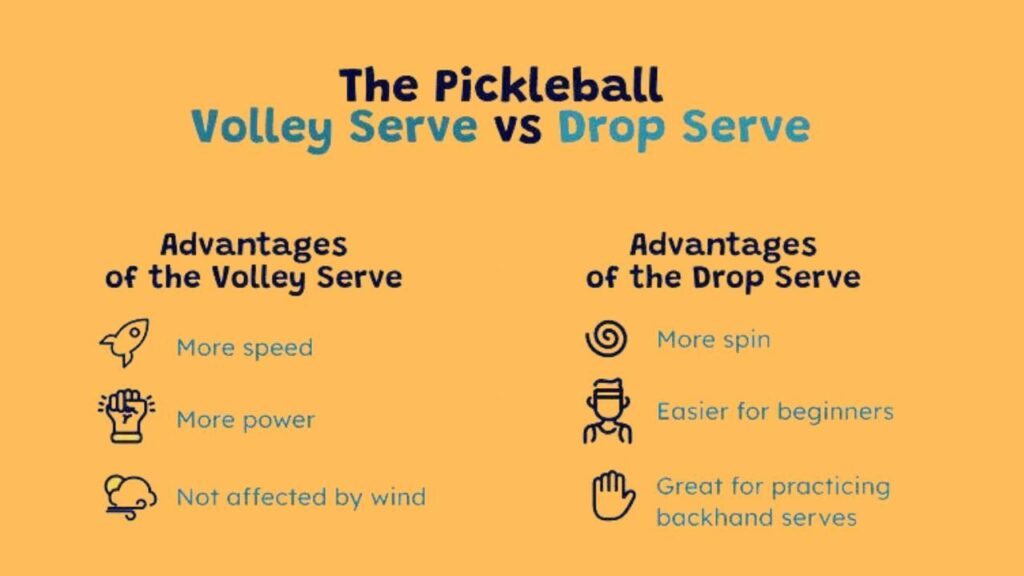
There are two legal types of serves in pickleball: the traditional volley serve, where the ball is struck before it touches the ground, and the drop serve, where the ball is dropped (from any height) and then struck after it bounces on the ground.
In 2022, the drop serve was added as a provisional rule for several reasons, including its suitability for beginners. Since then, even advanced players have adopted it and have found success using it.
One significant difference between the volley and drop serve is that the latter has fewer rules to follow. The server can drop the ball from any height, use an open palm to do so, and strike the ball in any manner after it bounces, eliminating rules 1, 2, and 3 mentioned earlier. While the ball can bounce multiple times, it must be within the court boundaries, and the server’s feet must be in the proper position. It is not allowed to toss or propel the ball upward or downward, simply drop it.
The Pros and Cons of Each Type of Serve
In pickleball, the traditional volley serve is known for its speed and power. To achieve maximum impact, the ball should be hit just below the server’s navel. On the other hand, the drop serve creates a lower contact point and is more suited for adding spin to the serve. This technique can make it difficult for opponents to return the serve, but it is not commonly used by professionals who prioritize generating power with a volley serve.
Drop serves are more commonly used by beginner and intermediate players as a practice tool to develop their serve technique. While the traditional volley serve remains the most common serving style, the incorporation of the drop serve as a legal serve option in 2022 may lead to changes in serving preferences. The rules regarding drop serves are relatively new, but they are expected to remain in place in the future.
The Pickleball Serving Sequence
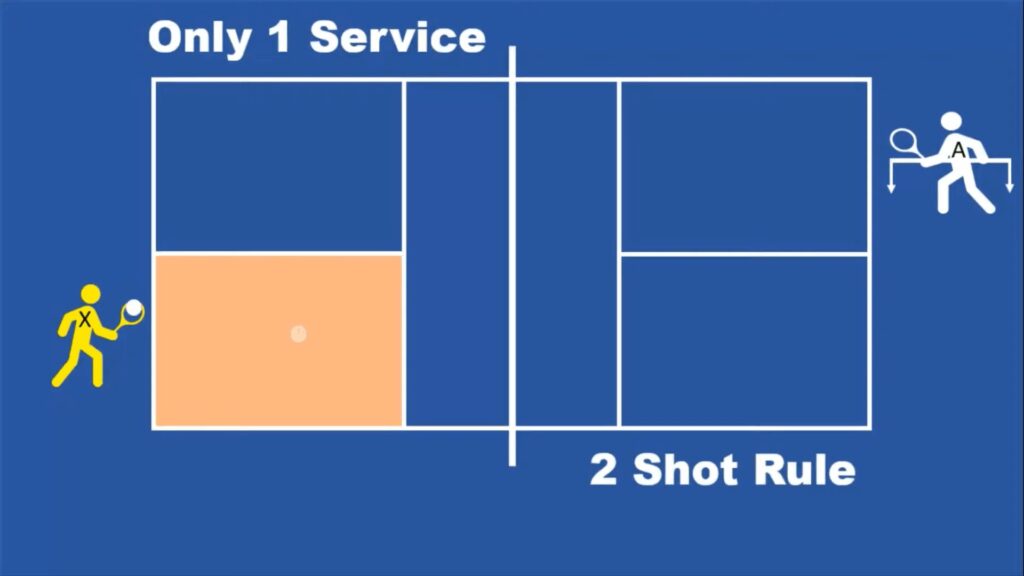
Next, Let’s discuss the serving sequence in pickleball. The order of serving is specific and follows some rules.
Before the serve, the score is called out loudly by the server, which is their responsibility. The opposing team should also hear the score, and it lets them know that the server is ready to start.
In doubles, the player on the right side of the court serves first at the beginning of the game or after a side-out. However, in singles, the service side depends on the score.
Being the first server is an advantage as they get to score first, but it also means that if they fault, a side-out is called, and the serve goes to the other team. After a side-out, both players get a chance to serve.
The scoring system in pickleball consists of three numbers: the serving team’s score, followed by the opponent’s score, and then either 1 or 2, indicating the first or second server after the side-out. For example, a typical pickleball score may read 6-3-2, which means the serving team has a score of 6, the opponent’s score is 3, and it is the serving team’s second server after a side-out.
These rules should be followed to ensure a fair game of pickleball.
What Are the 3 Things You Need to Know for a Pickleball Serve?
To comply with the rules of a legal pickleball serve, and avoid 3 of the most common serving mistakes in pickleball, commit the following into your play:
- Positioning: Both feet have to be behind and not touch the baseline in any way.
- Serving Motion: Volley serves have to be underhand, and drop serves must let the ball fall to the ground and bounce before you make contact.
- Placement: The ball has to be served into the quadrant diagonal from you and never land in the non-volley zone, which includes the non-volley line.
Reading this over, it may not sound too hard to complete the fundamentals of a legal serve. However, there’s a lot to unwrap for all three.
So let’s go in-depth for each rule for the sake of absolute clarity.
Rule #1: Positioning – Do Not Touch the Baseline
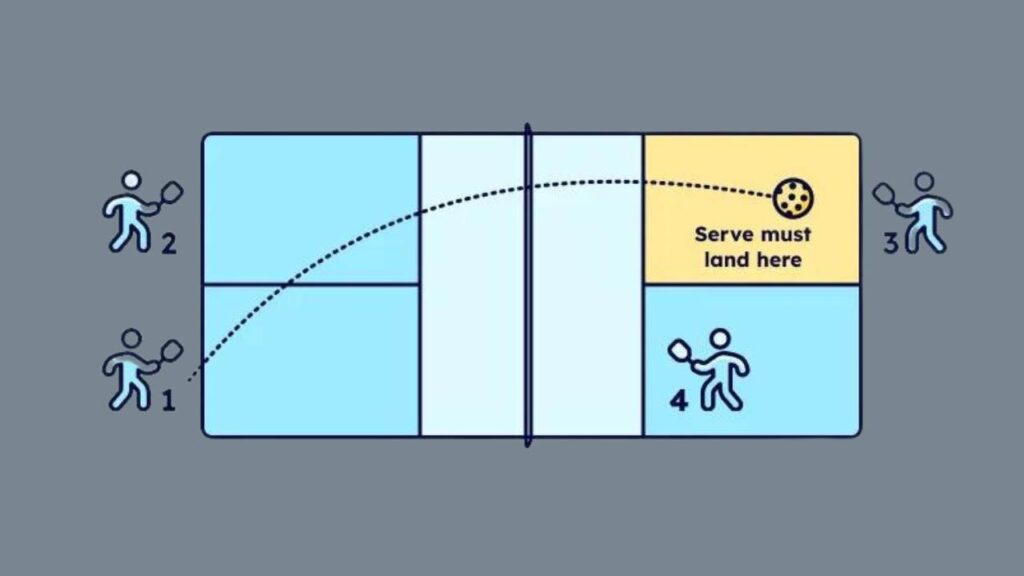
In pickleball, the serve is initiated by the server’s position. It’s important to remember that players are not allowed to touch the baseline, which is the back line of the court parallel to the net and separates the court from the out-of-bounds area. If a player touches the baseline during their serve, it’s considered a foot fault.
To clarify, the baseline is the line at the back of the court that runs parallel to the net and separates the playing area from the out-of-bounds area. If you touch this line during your serve, it will be considered a foot fault.
In pickleball, a fault occurs when a player or the pickleball violates a rule, which leads to a stop in the game known as a dead ball. For more definitions and terminology related to pickleball, beginners can refer to Paddletek’s pickleball glossary.
In pickleball, after a dead ball that results from a fault on your side, your partner (if you were the first server in doubles) or the other side gets the chance to serve. If the receiving team commits a fault, then the serving team earns a point.
Keep in mind, you can serve the ball anywhere in your opponent’s service court, as long as it’s between the no-volley zone line and the baseline.
As it relates to positioning, there are a couple of miscellaneous rules to be aware of:
- When serving in pickleball, it is important to stay within the designated areas of the court. You cannot cross the imaginary intersection of the centerline or sideline during your serve. This rule is outlined in section 4.A.4.c of the official pickleball rulebook.
- When serving in pickleball, it’s important to keep at least one foot on the ground and behind the baseline. This means that you cannot jump or step over the baseline while serving.
Rule #2: Arm Motion – Volley Serve and Drop Serve Regulations

The volley serve is the most commonly used form of serving in pickleball, but there is also an alternative called the drop serve. Each type of serve has its own set of rules, but both can result in a fault if not executed correctly.
This section will break down how to do both styles of serving legally.
The Volley Serve
Source Of Information (4.A.7.)
When you think of serving in pickleball, the volley serve is likely the first type that comes to mind. It involves using one hand to toss the ball and the other hand, holding the paddle, to hit it in the air before it bounces on the ground.
Several things make it unique, but the most important of them is how all volley serves must be underhand. This is measured and enforced in the following ways:
- The ball and paddle can’t make contact above the waist. (4.A.7.c.)
- The server’s arm has to move in an upward arc. (4.A.7.a.)
- The highest point of the paddle head cannot be above the highest part of the wrist. (4.A.7.b.)
The good news is that serving underhand feels more natural than overhand, Many players find it easier to serve underhand rather than overhand when using the volley serve in pickleball. It’s worth noting that serving the ball overhand during a volley serve is considered a fault. If this is a challenge for you, the drop serve is a legal alternative to consider..
The Drop Serve
Source Of Information (4.A.8.)
The drop serve was made a legal serving technique in 2021, and it differs significantly from the traditional volley serve, which is why it has its own set of rules.
To execute a drop serve in pickleball, a player can either use their non-paddle hand or their paddle to toss the ball up to any natural height. Then, without imparting any force or spin on the ball, they must drop it. The ball must then hit the ground at least once before the player can hit it.
By following the basic rules of raising the ball to any natural height and dropping it without applying force or spin, the server in pickleball can hit the ball however they want and at any time, provided that it has bounced at least once.
Unlike the volley serve, the drop serve does not have the same restrictions, such as not making contact above the waist, the arm moving in an upward arc, or the paddle head position relative to the wrist.
One potential drawback of the drop serve is that it typically results in a lower bounce, usually waist-high or lower. This makes it difficult to execute an overhand serve with this method, as the ball is unlikely to bounce high enough.
The drop serve can be an easier option for beginners to start serving in pickleball. However, as of now, professional players do not commonly use it.
Rule #3: Placement – Must Serve to Diagonally Opposite Service Court
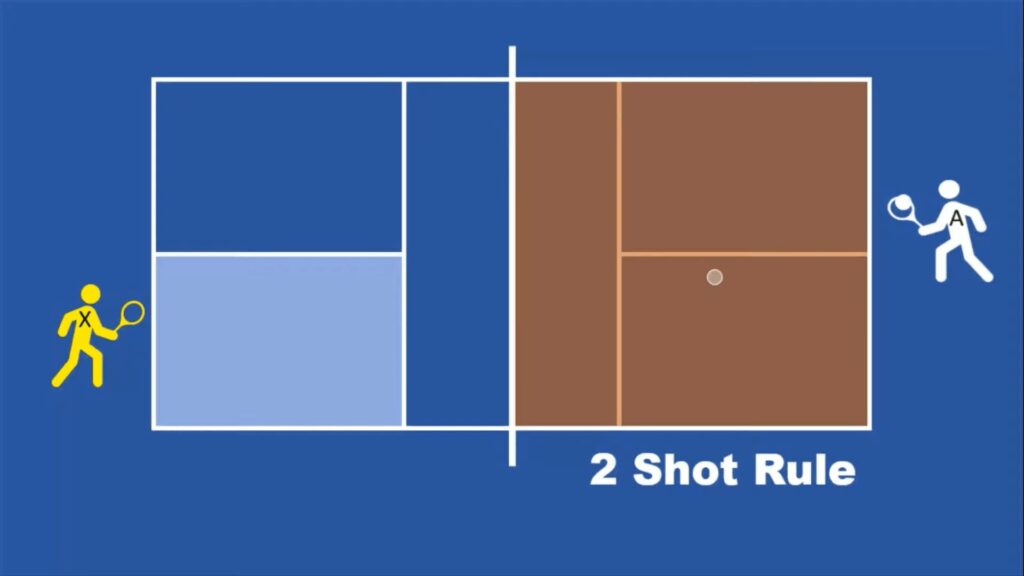
The rule appears straightforward: the server must accurately place the serve in the designated area, similar to other racquet and paddle sports. However, Pickleball has specific court requirements that must also be adhered to.
The area known as the kitchen or non-volley zone in pickleball must be completely empty before serving the ball for it to be considered a legal serve, as stated in rule 4.M.5. This rectangular area is located on both sides of the net and extends 7 feet in each direction from the net line.
In pickleball, the service court is defined by the end of the non-volley zone line, and includes the centerline, sideline, and baseline.
Even though a serve may land diagonally from the server, it will only be considered as a legal serve if it clears the entire non-volley zone, including its boundary line, and lands in the proper service court.
It’s common to accidentally land serves in the non-volley zone and its boundary line when learning how to play pickleball. However, it’s recommended to aim for a deep serve as it is a better strategy. This will minimize the chances of your serve landing in the non-volley zone and its boundary line, hopefully only happening as a result of technical error.
Let’s look at why it’s better to serve deep.
Pickleball Serving Faults
Pickleball serving rules are contained in the official pickleball rulebook, and any breach of those rules can result in a ‘fault’.
Here are four common service faults:
- Foot Faults: A “service foot fault” is a common sort of fault. When serving, the server must keep at least one foot on the ground (no hopping). Your feet must be behind the court’s baseline and inside the centerline and sideline’s imagined extensions. The baseline must not be touched by your feet. Any of these regulations you violate are wrong.
- Illegal Serving Motion: Recall how we discussed the pickleball serving motion above? A serve must be delivered with an upward arc and the paddle must make contact with the ball below the player’s waist (it may be delivered with a forehand or backhand action). If not, it is considered to be an illegal serve, and a fault is reported.
- Wrong Player Serves: Sounds easy, yet it’s a simple error to make. Remember whose time it is to serve, please! Ask your partner, your opponent, or the referee if you are unsure.
- Serve Lands Out of Bounds: The opponent’s service box must be reached by hitting the serve diagonally and across the server’s court. A mistake has occurred if it lands outside of the rectangle. To the following player, the service is transferred. The non-volley zone line (kitchen) must be crossed by the ball. It is flawed if it touches that line. The baseline, centre line, and sideline are all, however, taken into consideration.
What is a “let” in Pickleball?
When a rally is redone for any reason, it is called a let. Following a let, no points are scored. If something from outside the game prevents play, a let may occur. For instance, your dog may catch the ball and take off after it. However, a service let is the most typical kind of let.
A service let happens when a serve results in the ball hitting the net but still landing in the appropriate service court. When the ball brushes against the top of the goal, this typically occurs. If a service let happens, the serve is redone without incurring any penalties. A let can be yelled by any player or official. The number of successive lets is unrestricted.
It is a fault if the serve’s ball strikes the net but does not cross it. A fault is also committed if a serve results in the ball crossing the net and landing in the “kitchen” or elsewhere outside the service court. The ball is in play if it touches the net during any shot other than the serve.
Are There Lets in Pickleball?
What is a “Let” first of all? A serve that hits the net and then lands in the appropriate service box is known as a let serve.
A let serve is replayed in tennis.
A pickleball let serve was also replayed prior to 2021. The USA Pickleball Rules Committee, however, came to the conclusion that the regulation made the game less fun, increased disagreements, and made things more difficult for both players and referees.
Any reference to a let serve was subsequently deleted from the rules when the rule was altered. Now, play continues even if the ball strikes the net and lands in the proper service area!
Pickleball Receiving Faults
Just like there are pickleball service faults, there are three faults that might be committed by the receiver of the serve.
- Hitting the return before the ball bounces: The most typical receiving error occurs when a player touches or strikes the ball before it bounces into their service area. Keep in mind that before a return shot (groundstroke) is fired, the ball must first bounce.
- The wrong receiver hits the ball (or is hit by the serve): Another frequent mistake is positioning the members of the receiving team on the wrong side of the court, which results in the wrong player receiving the serve return. This might also happen if the serving player strikes the non-receiving player while they are playing too near the centre line at the kitchen line. This includes situations where they merely block the path of the serving ball.
Asking for timeout or score correction too late: Players in pickleball can request a timeout or inquire about the score from the official. However, once the server has begun their service motion, a receiver cannot do either of these things because it would be disruptive.
Pickleball Serve Positioning
Let’s now take a look at pickleball serve positioning. Where should each player stand for the serve?
Of course, we’re talking about doubles here, meaning there are four players on the court, which we’ll number 1-4.
- The Server: Players frequently stand a few inches away from the baseline to reduce the chance of making a foot error. It is essential to make sure the server is positioned within the centre line, sideline, and any fictitious expansions of those lines.
- The Server’s Partner: The non-serving partner is free to position themselves as they like, according to the regulations. However, it is advised that they remain out of the way and behind the baseline. The ball must first bounce before they make contact with it.
*The “Double Bounce Rule” Explained
Pickleball Receiver Positioning
- The Receiver: The receiver usually stands one or two feet behind the baseline, in a central position to the service area. This maximizes their ability to return the serve.
The Receiver’s Partner: The non-receiver will usually position themselves at the kitchen line since by the time the ball comes to them they will not have to let it bounce. In this position, they will be ready to smash back the serving team’s second shot.
Top 5 Pickleball Serving and Receiving Tips
Here are a few tips we’ve picked up over the years:
- Watch the Ball, Not Its Trajectory: It’s very easy to take your eye off the ball and focus on where you think it’s headed or where you want to hit it. Don’t! Keep your eyes on the ball until you’ve actually made a good connection.
- Keep Your Opponents Guessing: By mixing up your serves, you’re more likely to catch your opponent off guard. Try powerful, deep serves, lob, and shorter serves with backspin and hitting different parts of the service area each time. Also, work in a drop serve from time to time. The best way to achieve a good mix of serves in your armory is by doing pickleball serving drills as often as possible.
- Don’t Try to Ace Every Serve: When you’re starting out in pickleball, don’t try to hit every shot like a pro. Aim for consistent, legal, and playable serves and you’ll have much more fun on the courts.
- Keep your opponents back: Since most of your points will come from being positioned at the kitchen line, try to hit your serve as deep as possible. Short serves bring the receiver up to the kitchen.
Similarly, hit your serve return deep to your opponent’s court and with a little arc. This will allow you extra time to get yourself to the kitchen line. - Try aiming for different targets: Serving to the middle of the service court is always safest. After all, as a beginner, you really just need to put the ball in play. As you become more comfortable with your serve, try aiming to various points, such as your opponent’s backhand side or specifically to their right or left side. You might also try varying the pace of your serve as you improve.
Does Each Player Serve in Pickleball Doubles?
Only one player from the team that chooses to serve first in the match is allowed to serve before the first error. In a pickleball match, the beginning score is 0-0-2, signifying that a side out will take place following the first fault. Remember that the server number is the last digit in the score.
Both players on each team will then get the chance to serve between each side out for the remainder of the match.
The server on the right will always be the one to play on at the beginning of the game and after each side out. They will trade places with their partner if a point is scored. They switch to the opposing side of the court and continue serving.
Pickleball requires the serving team to reverse sides and serve once again after a point has been scored. However, if an error happens, they will remain on their side and either pass the serve to their partner or declare a side out.
How do you know who wins?
Points are only scored by the serving team. Games are to 11 points, but you must win by 2 points.
Back to the Baseline
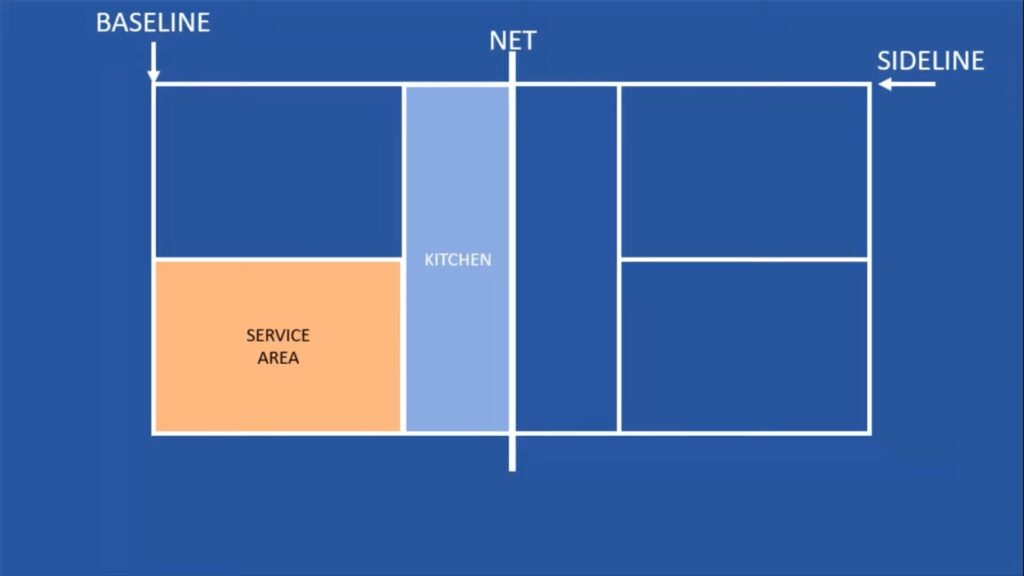
We hope our explanation of pickleball serving has provided you with valuable tips to enhance your gameplay. Initially, the rules of pickleball serving may appear complex for beginners, but with practice, they will become more comprehensible and natural.
If there are any local variations on the aforementioned rules or any serving tips that you would like to share with other pickleheads, please feel free to communicate with us on social media.
Furthermore, if you have any questions regarding pickleball serving rules that we can help you with, we would be delighted to answer them.
Until next time, happy pickling!
Frequently Ask Questions
Practice, Practice, Practice
Mastering each type of serve requires practice, as putting the ball in play is the crucial aspect of serving. Missing shots when attempting advanced serving techniques can negatively impact your game, given that you can only score on your serve.
Aside from varying your serves, it is essential to consider when to employ each type and the intended ball placement.
Resources
https://www.youtube.com/watch?v=fK4bFs6RkdI
https://www.youtube.com/watch?v=gd8_SAqrRuk
https://www.youtube.com/watch?v=dPYTI6Iy08k
